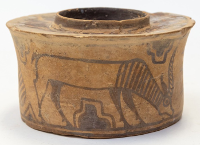|
Jar Used for Toothbrush Dates to Ancient India
December 6, 2018
When is a toothbrush holder like a 4,000-year-old artifact? When the owner doesn't know what he really has in his bathroom. Karl Martin, an Englishman who frequents yard sales, picked up a small piece of pottery at such a sale, in Willington, Derbyshire, about five years ago. He paid £4 (US$5) for the small jar and for another piece of pottery. He liked the painting of an antelope that was on the jar. Martin put the jar, which has a small hole at the top that widens into the rest of the jar below, in his bathroom; in the jar he kept his toothbrush and toothpaste. As it turns out, the jar was made by a member of the Harappan civilization, which lived in the Indus Valley in what is now India about 4,000 years ago. The civilization, in its heyday, rivaled that of the Nile and Yangtze River civilizations in what are now Egypt and China. The highly advanced Harappan civilization died out suddenly, leaving behind many mysteries. Martin had the first clue that he had a rather distinctive toothbrush jar when he saw something similar while helping a friend unload pottery set for auction. The friend was James Brenchley, the head of antiquities at Hansons, an auction company. Brenchley took a look at his friend's jar and confirmed that it dated to 1900 B.C. Martin cleaned the jar up and put it up for auction, at Hansons Auctioneers. The jar sold in November, for £80 (US$100) in November 2018. Martin now works at the auction house. |
Social Studies for Kids |
Social Studies for Kids
copyright 2002–2019
David White





